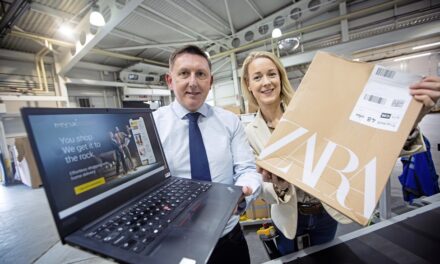
The race to deliver
Even for companies more than holding their own in a tough e-business environment, stories of goods arriving late, later or never still cause planty of nightmares. After all, the work at the front end, creating a web site, is the easy bit. Knitting the whole operation together is where the difficulties arise, as integrated logistics, delivery and services fall under the spotlight of customer expectations – and consistently fail to live up to them.
E-fulfilment is the weakest link in so many e-businesses because it involves involves a far wider range of activities which are critical to the long-term success of e-business, and highlights the importance of partnerships and collaboration. If fulfilment is weak at any point in the chain, then the whole enterprise could be threatened.
E-fulfilment matters. Why? Because it is the one tangible point of contact that online companies have with their customers. An e-business may have the most advanced web site and the widest service offering, but unless customers receive the goods, as well as the post-sales support, everything that happens upstream counts for nothing.
A good example is the failure of eToys.com to deliver its products on time during the run-up to Christmases past. The company was unable to meet the short-term rise in internet sales volumes, leading to a dramatic fall in consumer confidence. This has had a dramatic effect on eToys.com’s sales volume and stock price. And it was not only eToys.com that ran into trouble. Established names, such as Macys, had similar problems.
This led market research firm IDC to conclude that many e-tailers have not been able to deliver the service standards that customers expect. Its report, The growing role for e-fulfilment specialists, says: "Reports suggest that e-tailers are generally offering a poor service and are not satisfying their customers’ needs. If there is one thing that the first generation of e-tailers learned, it is how critical customer satisfaction in the early take-up phase of their businesses can be."
But, amid the chaos, e-fulfilment also has its champions. Amazon blazed the trail, and others have cleaned up their acts to match the high standards the company and others have set. There are numerous examples, but we’ve picked out three outstanding examples of e-fulfilment to show how it can be done: The Entertainer, a toy retailing success; high street stalwart Boots the Chemist; and the traditional pottery maker Wedgwood (see box, page 38).
Indeed, there are signs of optimism, as many companies are quite satisfied with their e-fulfilment capabilities. According to the eCom Index, published by consultancy firm CMG, of the 15 per cent of UK companies that report more than one per cent of revenues coming through e-business, less than a quarter believe fulfilment will let them down. As many as 28 per cent believe their companies’ capabilities are ahead of the competition.
But research from PricewaterhouseCoopers shows dot coms in a poor light. "Even now, e-fulfilment is not rated as important by dot coms," says analyst Anthony Hatter. "They are ignoring their customers – focusing more on leadership and strategic partnerships, and less on fulfilment and web site design."
Amazingly, only 15 per cent of dot coms believe fulfilment is important to success, while almost one in three traditional companies rate first-class fulfilment as important. This may explain why two out of three e-fulfilment champions have old-economy roots.
Companies can face different problems when grappling with e-fulfilment. Small and medium-sized businesses are particularly vulnerable, since, as a recent report by analyst Butler Group points out, problems can quickly arise for SMEs testing the waters of b2b. "Unexpected orders from new sources can overwhelm existing processes and systems, unless these are very carefully managed,"the report says.
"If a book or CD arrives late, it is an irritation to the consumer, but if business deliveries are mishandled, the damage to the company’s reputation could be catastrophic," it adds. "A range of disciplines and systems may be required in order to prevent this. However, logistics-related services can be expensive to establish and maintain, presenting a barrier to smaller players."
The report goes on to point out that the costs of investment in delivery systems is generally high. The use of a reliable third-party logistics service could be the solution to this problem, although Butler Group also points out that companies need a comprehensive service, which can be hard to find.
Outsourcing is the obvious route to take, and deep partnerships between SMEs and fulfilment companies are increasingly common. One example from the US is Nana’s Candles working with fulfilment operator PushLoop. The mother-and-daughter business sells candles worldwide over the web, but suffered from the traditional seasonal spikes in demand. It was in dire need of help with its web site and storage problems.
The solution was to hand all inventory over to PushLoop’s warehouses in Atlanta and the Netherlands. All the business partners have to do is to check mail for orders and process the charge card information, with PushLoop taking control of the rest of the process.
Another area that outsourcing partners can help with is understanding the whole value chain, since e-businesses might launch new products and services without having the time to think through every stage of delivery to fulfilment. Iain Gray, head of marketing at ufulfil.com, says: "With a new client in the fireplace market, we are involving retailers and suppliers, auditing the supplier’s processes, designing new methods of handling the product and, most importantly, testing the concept."
He also points out that fulfilment experts understand the total cost of fulfilment. "A lack of understanding of the total cost can lead to the development of an unprofitable and uneconomic commercial model," he says. "A typical product can cost around £8 to fulfil in total."
CMG e-business director Phil Race claims that the difficulty of implementing the necessary fulfilment mechanisms is second only to the high cost of telecommunications in holding back UK business online.
More and more companies are relying on parcel delivery to get goods to customers. Competition is intense among sector players constantly looking to outdo one another in quality of service, the key differentiator. Even so, thousands of parcels go missing or are wrongly delivered every year in the UK, representing not only thousands of disgruntled customers, but also hundreds of thousands of pounds of extra costs to parcel delivery firms.
A relatively new venture, Online Express Parcels, has sought to eliminate human error from the start by launching a paperless operation. "Parcels end up at the wrong destination, so-called misroutes, because of mistakes in the paperwork," says managing director Mark Slater, formerly of Amtrack’s parcel delivery company. "For example, the code for Bristol, BS, is easily confused with the code for Bradford, BD. But the two places are a long way apart, so when the mistake is made companies, have to pay exorbitant prices for same-day delivery vans to solve the problem."
Other human errors creep in when parcels are picked up. For example, in a large batch some parcels may get left behind or have the wrong labels attached to them. Customers enter details on a web site, requiring no re-keying of information. "They do not want to fill out lots of paperwork anyway," adds Slater. A print-out of order details, including a unique barcode which is also included on labels attached to the parcels, is sent to the driver. Scanning these barcodes as parcels are loaded and unloaded creates a real-time record of their location, allowing precise delivery tracking. An additional feature due to be added to the system is the generation of maps for drivers showing the quickest delivery routes.
Large, well-known companies, such as the former Post Office, now Consignia, are also moving into the fulfilment space. Consignia has launched a one-stop-shop to support firms involved in e-commerce and home shopping services, backed by a £14 million investment.
Its opposite number in Guernsey is also taking steps to boost fulfilment. Guernsey Post Office’s commercial director, Richard Brache, believes the island’s unique fiscal and physical situation could make it ideal for e-tailers, particularly those selling low-value items. The advantages are twofold. First, as the Channel Islands are Crown possessions outside the EU, no VAT is levied on goods produced in, or imported into, the islands. Second, there is de facto VAT exemption on low value goods exported from the islands. The Channel Islands could emerge as an unexpected focal point for fulfilment to UK consumers buying over the web.
Tell us about your e-fulfilment champion. E-mail us at [email protected]













